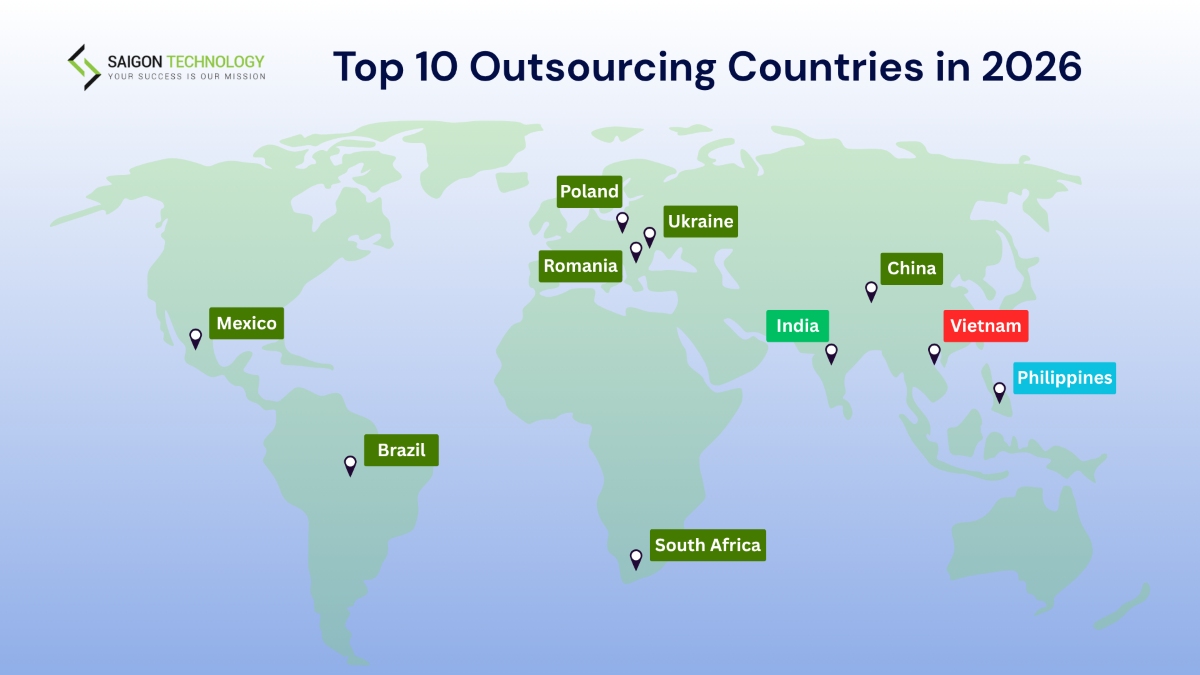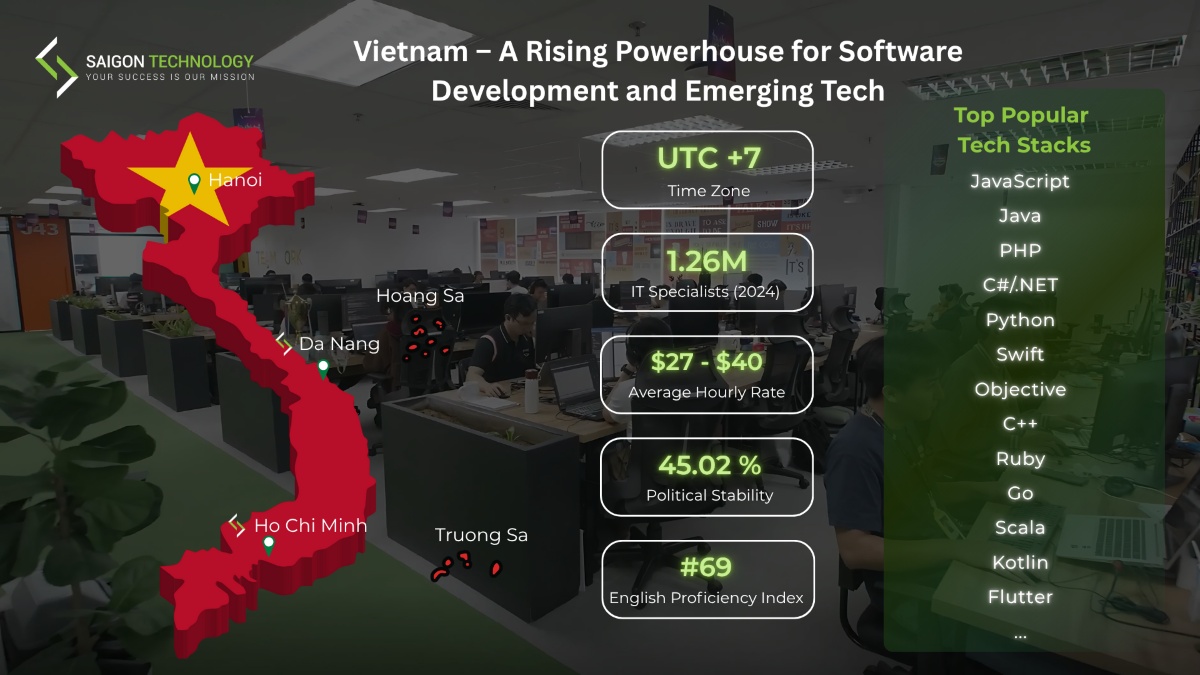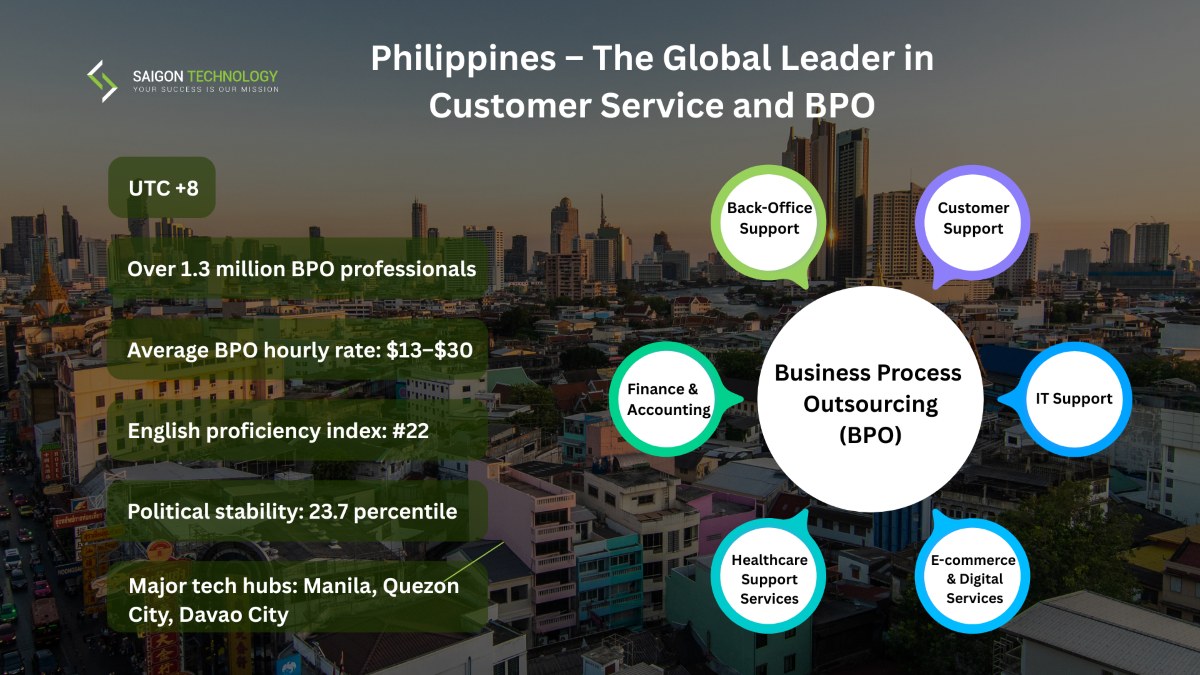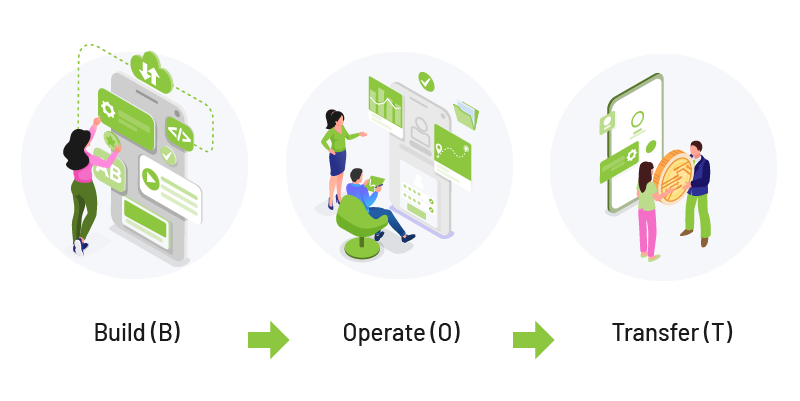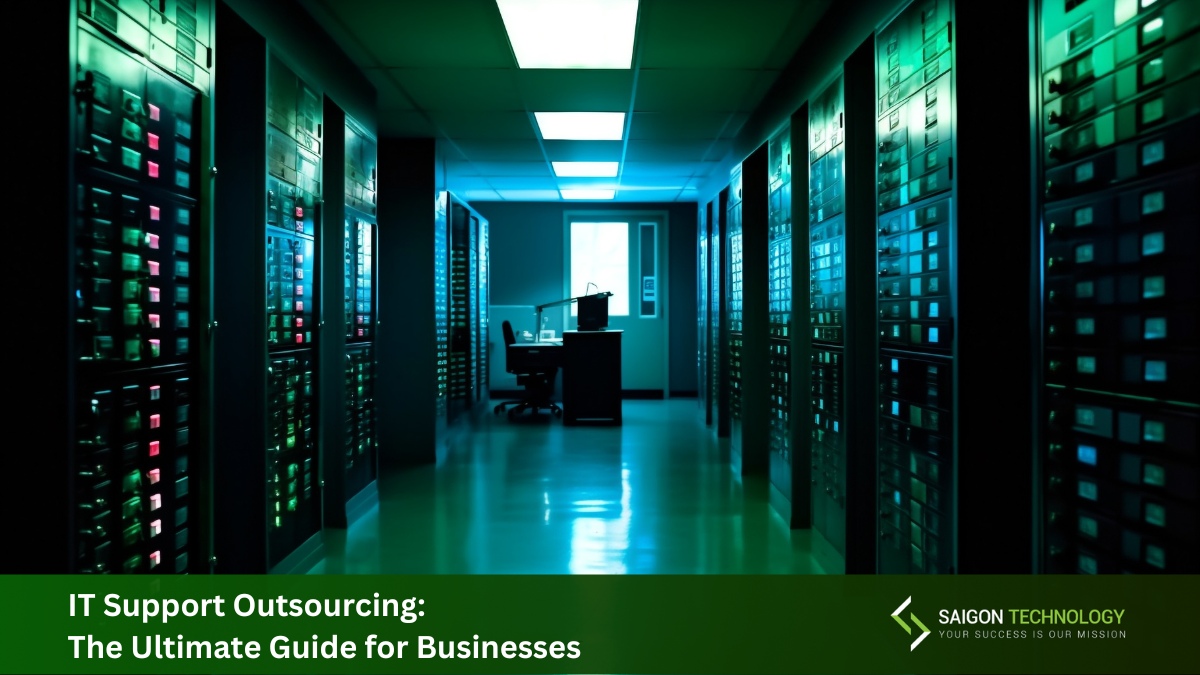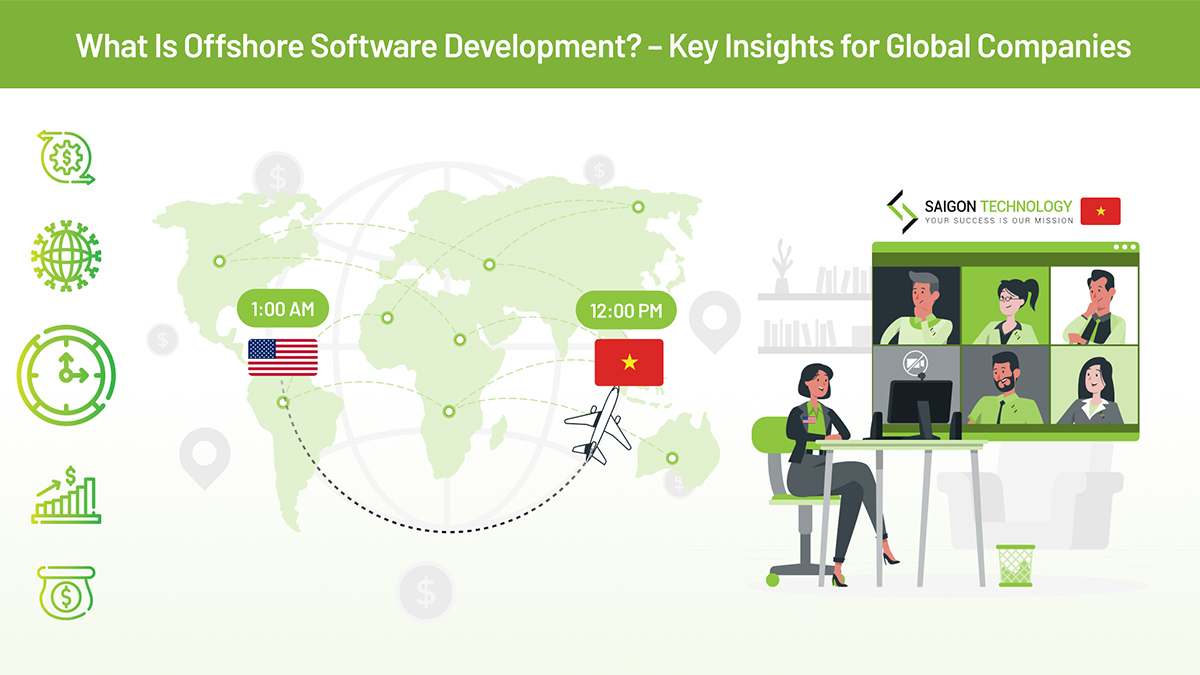Good outsourcing countries help the US, EU, and Australian businesses achieve cost savings. This approach gives you access to a global talent pool. You can scale quickly while ensuring quality. Yet, how can you find a perfect outsourcing partner with too many options? You should focus on their English proficiency and technical expertise. Cultural diversity also affects your partnership. Thus, consider cultural differences, too.
Saigon Technology, with over 13 years of experience and 800+ successful outsourcing projects, breaks down the top outsourcing countries right here. We highlight their strengths, costs, talent pools, and best-fit use cases. For example, the Philippines stands out as a prime choice in the global BPO market. The BPO industry here was about US $38.7 billion in 2024. About 1.3 million workers are engaged in this sector.
Read on to discover more! In the end, you can settle on your ideal destination!
Top Outsourcing Countries for Cost Savings and Quality Services
You have tons of choices, but some countries stand out for their expertise and cost efficiency. Keep scrolling for the top ten global leaders!
1. India – The Global Powerhouse of IT Outsourcing
India is among the best countries for outsourcing software development. US companies value their cost-effective advantage and skilled software developers. India has a vast talent pool of 5.4 million IT professionals. Besides, the country has worked with Western businesses through every kind of outsourcing agency. The most outsourced services are software development, application services, and IT support.
Advantages:
-
World’s largest IT talent pool: There are hundreds of thousands of STEM graduates every year. You can choose IT experts skilled in advanced areas like cloud computing, AI, and DevOps. The talent in data security and cybersecurity is easy to find as well.
-
Strong English proficiency and global experience: English is a popular language here. Thus, Indian companies can minimize the communication barrier. Most providers also understand Western demands and work styles. Cultural differences won’t interrupt your project!
-
Cost efficiency: Average hourly rates for Indian developers range from $20 to $40. This range is much lower than the US rates of $80 to $150. Hence, companies won’t overspend while scaling their resources.
Disadvantages:
-
Time zone difference: There is a gap of 10 to 12 hours between India and the USA. Hence, real-time conversations can be hard. Many Indian firms offer flexible work hours. They even work on overlapping shifts to solve the problem. Yet, you still need regular meetings and rapid feedback cycles.
-
Quality variation among vendors: The outsourcing market here includes providers of many levels. You may meet world-class firms or lower-tier vendors. It means that you have to select your partner carefully. Otherwise, you will face communication issues and poor quality.
-
Infrastructure gaps from city to city: Big tech spots like Bengaluru, Hyderabad, and Pune offer good facilities. But the smaller cities might have problems with the power sometimes. Poor internet speed and logistics can also impact project timelines.
Best For:
-
Software development: Web, mobile, and enterprise applications.
-
IT support and managed services: 24/7 help desks, infrastructure monitoring, and maintenance.
-
Application modernization and cloud migration: Large-scale enterprise projects with deep technical expertise at lower cost.
2. Vietnam – A Rising Powerhouse for Software Development and Emerging Tech
Among the best countries to outsource software development, Vietnam has become one of Asia’s most dynamic IT outsourcing hubs. Many Western companies choose Vietnam for business software development and quality assurance. They can quickly find an outsourcing partner in new tech like AI and machine learning. Vietnam also receives strong government support. The fast-growing tech workforce is impressive, too. Clients can obtain quality, innovation, and affordability right here. That’s why Vietnam is always on the list of the best countries for outsourcing.
Advantages:
-
Fast-growing IT sector with strong government support: The government is putting more focus on technology. Their efforts encourage foreign investment and tech collaboration. Moreover, the country invests heavily in education, startups, and IT infrastructure. The Vietnamese outsourcing market has been growing at an annual rate of 16.38%. Major foreign investors include Intel, IBM, Samsung, Microsoft, and Nvidia. Political stability is balanced, around the 45th percentile.
-
Competitive labor costs: Hourly rates range from $27 to $40 in Vietnam. Cost savings make this country ideal for startups and enterprises seeking to scale efficiently. The best thing is that you don’t have to sacrifice quality.
-
Young, skilled talent pool with strong STEM education: With a median age of 32, Vietnam has a large young workforce. There are thousands of new IT graduates in engineering and computer science each year. Businesses also do not need to worry about English proficiency. English education, particularly for business culture, is improving rapidly.
-
Work Ethic and Attitude: Vietnamese developers are known for being hard-working and disciplined. Many come from backgrounds where persistence and self-learning are valued. Moreover, you will be impressed with your respectful and team-oriented partner. Vietnamese vendors tend to avoid conflict and maintain harmony. Thus, collaboration will be smoother. Plus, Vietnamese engineers are eager to learn. They often invest personal time in improving English. New frameworks and global coding standards are also part of their priorities.
Disadvantages:
-
Smaller talent pool compared to India: Vietnam’s tech sector is still growing. Yet, its talent pool is smaller than India’s. Hence, large-scale projects may face resource constraints.
-
Time zone gap with the U.S.: A 10 to 12-hour gap with US clients can affect real-time teamwork. Many firms, like Saigon Technology, adopt flexible schedules to ensure smooth collaboration.
Best For:
-
Software development: Web, mobile, MVP, and enterprise applications built cost-effectively without compromising quality.
-
Quality assurance (QA) and testing: Dedicated testing teams for continuous integration and deployment pipelines.
-
AI and machine learning projects: Increasing expertise in data science, predictive analytics, and computer vision.
3. Philippines – The Global Leader in Customer Service and BPO
The Philippines stands out as one of the top software outsourcing countries. It’s known for exceptional outsourcing services in customer support. Other popular services are call centers and business process outsourcing (BPO). Over 1.3 million skilled Filipino workers engage in the BPO sector. Your partner combines excellent communication skills and high cultural compatibility. Thanks to their expertise, you can deal well with customer-facing and back-office operations. All come at lower hiring costs due to the low local cost of living.
Advantages:
-
High English proficiency and Western culture fit: The Philippines is always one of the top Asian countries in English ability. Moreover, the Filipino workforce is familiar with US culture. They have no problems when working with the media and business etiquette. Thus, your experience feels natural to America.
-
Global leader in customer service and BPO: The country is the top destination for BPO. Clients can handle call centers and virtual assistance. Finance, HR, and healthcare support improve then. Even major US corporations operate dedicated service centers here.
-
Large and experienced workforce: There are more than 1.3 million professionals in the BPO industry. They have decades of experience serving North American clients. This mature outsourcing market can handle both volume and quality demands.
Disadvantages:
-
Limited skills in advanced tech: The market is famous for customer support and process outsourcing. Yet, it lacks talent in advanced software engineering. So, if you work on AI and high-complexity R&D, the Philippines may not be an ideal option.
-
Exposure to natural disasters: The location exposes the country to typhoons. Unexpected power cuts can also cause trouble. Large outsourcing companies always have disaster recovery plans in place to deal with such issues.
Best For:
-
Call centers and customer support: Inbound and outbound support, technical help desks, and after-sales service.
-
Back-office operations: Finance and accounting services, HR processing, data entry, and virtual assistant services.
-
Multichannel customer experience: Voice, chat, email, and social media support tailored to U.S. customers.
4. Poland – A Premier European Hub for High-End Software Development
Poland is one of Europe’s top outsourcing countries. US businesses often seek high-quality software development, cybersecurity, and enterprise solutions here. They even regard Poland as the best country to outsource software development in the region. It offers skilled talent and adheres to EU standards. Companies here also align with Western business culture. All these strengths make it a reliable partner for complex and mission-critical projects.
Advantages:
-
Skilled engineers and strong European standards: Poland is among the top countries when it comes to programming. The high rank reflects its technical education level. Each year, Poland welcomes more than 75,000 graduates. Its developers are known for advanced technical expertise in software architecture. Businesses can also find talent in cloud solutions and secure IT infrastructure. You need them for enterprise-grade systems!
-
Cultural and work-style fit with the U.S. and the EU: Poland’s working culture shows shared cultural values with Western countries. Moreover, it has time zone similarities, especially with the US East Coast. So, choose a partner with high English proficiency to ensure smooth communication.
-
Focus on fintech, cybersecurity, and enterprise solutions: Poland leads in complex software engineering. Thus, US businesses come here to seek fintech, cybersecurity, and enterprise solutions. Many Fortune 500 companies run R&D centers in Warsaw, Kraków, and Wrocław. Moreover, the country offers strong IP protection and advanced data security. In the US Chamber of Commerce’s IP Index, Poland ranked 17th with a score of 71.91%. From the rank, we can see that this country remains among the top global economies for IP systems.
Disadvantages:
-
Higher labor costs compared to Asia: Average labor costs for developers in Poland range from $35 to $60 per hour. The rate reflects EU-level quality and strong technical skills. An outsourcing company here charges you less than a US one. Yet, the rate is higher than in Asian hubs.
-
Talent competition within the EU: The strong tech reputation attracts global demand. But it increases competition for top software engineers. As a result, salaries are rising. It takes more time to hire specialized roles.
Best For:
-
Fintech and financial platforms: Secure payment systems, banking apps, and trading platforms.
-
Cybersecurity solutions: Threat detection, secure infrastructure, and compliance-driven development.
-
Enterprise software: ERP, CRM, and large-scale SaaS platforms requiring robust architecture and security.
5. Mexico – A Leading Nearshore Partner for U.S. Companies
Mexico has emerged as one of the top outsourcing countries for US businesses. You can enjoy nearshore convenience and cultural alignment. There is also a strong base of skilled IT professionals. Additionally, the country is located in the same or adjacent time zones as the US. Hence, collaboration will be easier. Close trade relations and similar business practices also help make cross-border projects efficient. All the strengths make Mexico a good destination for outsourcing services. The Tholons Top 20 Digital Nations list in 2021 ranked it eighth.
Advantages:
-
Nearshore access and time-zone fit: Mexico’s location is a big advantage for nearshore outsourcing. Thanks to time zone similarities, teams can work in real time. Nearshore services speed up decision-making. At the same time, you can reduce communication delays.
-
Easy travel and cultural similarities: Mexico offers strong cultural readiness for US companies. Frequent direct flights make travel simple. You can then make in-person visits and project kickoffs easier. A shared working culture is another advantage.
-
Large IT talent pool: Mexico has a large IT talent pool of over 300,000 professionals. Developers are known for their English proficiency. Plus, they have a lot of experience in working with US companies. Top universities introduce thousands of computer science and engineering graduates every year.
Disadvantages:
-
Security concerns in some regions: Major tech hubs like Mexico City, Guadalajara, and Monterrey are safe and friendly. But some places face security challenges. Hence, you must select reliable vendors to avoid risks.
-
Higher costs than in Asia: Labor rates in Mexico typically range from $25 to $50 per hour. India and Vietnam offer better rates. Yet, easier collaboration and lower travel expenses are trade-offs.
Best For:
-
Nearshore software development: Real-time collaboration on web, mobile, and enterprise applications.
-
Manufacturing support: Product engineering, prototyping, and industrial automation.
-
Supply-chain operations: Logistics management, procurement support, and integrated back-office services.
6. Ukraine – A High-Caliber Engineering and Product Development Hub
Ukraine is one of Eastern Europe’s leading outsourcing countries. US companies love its deep technical expertise and strong STEM education. As one of the top software outsourcing countries, Ukraine offers world-class talent. The competitive pricing also makes it a strategic choice for advanced software solutions.
Advantages:
-
Strong STEM education and skilled workforce: The STEM-based curricula make Ukraine stand out. The country has tens of thousands of IT graduate engineers each year. The skilled talent pool of 250,000 specialists has attracted many global businesses. Moreover, STEM education focuses on maths, engineering, and computer science. Thus, the graduates have strong problem-solving and programming skills.
-
High-quality product development and R&D expertise: Ukrainian developers can tackle complex projects. An outsourcing agency here deals well with full-cycle web and mobile app development. Plus, you can get top-notch DevOps, data engineering, and AI solutions. And they don’t just stand out with outsourcing tasks. Many US clients value co-developing core products and platforms.
-
Competitive pricing for advanced skills: Developers in Ukraine just charge you about $30 to $55 per hour. This rate is lower than in the US and Western Europe.
Disadvantages:
-
Geopolitical instability: Many Eastern European outsourcing countries face geopolitical tensions and conflict. So, long-term projects may be risky. Many companies reduce these risks by choosing agencies with distributed teams across Europe.
-
Possible delays because of conflict and infrastructure: Conflict and power issues may mess up your project. Top outsourcing companies handle this with strong backup systems. You also need recovery plans to keep projects running.
Best For:
-
Web and mobile app development: End-to-end product engineering, from MVPs to enterprise-scale platforms.
-
DevOps and infrastructure: Automation, CI/CD pipelines, and cloud architecture.
-
AI and data projects: Machine learning models, predictive analytics, and data engineering.
7. Brazil – Latin America’s Software Development Powerhouse
Brazil is one of the best countries for outsourcing software development in Latin America. The country offers a large, skilled workforce in fintech and SaaS. The shared time zones with the US are a benefit for those looking for a nearshore partner. Brazil delivers quality, scale, and convenience at the same time.
Advantages:
-
Largest software talent pool in Latin America: There are more than 500,000 software engineers here. You can find experts in web, mobile, cloud, and AI. The strong university system and a growing tech scene keep expanding this workforce.
-
Cultural fit and easier collaboration across time zones: Brazil has strong cultural alignment with the US. Thus, teamwork can be smooth and efficient. Moreover, most Brazilian cities work within one to three hours of the US time zones. The close time-zone alignment helps teams collaborate in real time more easily. The shared time is perfect for nearshore outsourcing.
-
Strong fintech and SaaS expertise: Among leading outsourcing countries, Brazil stands out for its strong fintech and SaaS expertise. It’s home to many global-scale fintech startups. The deep experience in digital payments, e-commerce, and SaaS product development helps you build secure, scalable platforms.
Disadvantages:
-
Higher labor costs than in some Asian countries: Developer rates in Brazil range from $30 to $55 per hour. Outsourcing to India or Vietnam must be more affordable. Even so, you may prefer the nearshore advantages.
-
Bureaucracy and complex regulations: The regulatory environment and administrative processes here may slow down operations. It would be best to choose experienced local vendors to avoid extended timelines.
Best For:
-
Software development: Full-cycle product engineering, SaaS platforms, and cloud-native solutions.
-
Fintech applications: Digital banking, payment systems, and financial platforms.
-
Nearshore outsourcing: Projects requiring real-time collaboration and rapid feedback loops.
8. China – The Global Leader in Manufacturing and Emerging Technologies
China is one of the top outsourcing countries. Clients love its huge scale in manufacturing and hardware. Besides, you can find talent in advanced tech like AI and robotics. If your company needs large hardware projects or R&D, China can provide strong innovation. You can also achieve capacity and cost efficiency.
Advantages:
-
Unmatched scale in manufacturing and hardware production: China is famous for manufacturing outsourcing. As the world’s largest manufacturing hub with a strong supply chain, it can provide complex hardware quickly. Chinese vendors can also deal well with large volumes. This destination is ideal for electronics, IoT devices, and other physical products.
-
Rapid advancements in AI, robotics, and automation: China leads in AI and machine learning. Many companies invest in smart manufacturing and robotics. Right here, you can speed up product innovation. This move gives you access to specialized expertise in high-tech areas.
-
Cost-efficiency for large-scale projects: The labor costs are rising in China. Even so, China remains competitive for large manufacturing and R&D projects. The average salary for skilled workers is still lower than in many Western countries. Strong infrastructure is impressive, too. Plus, a mature industrial ecosystem helps reduce production costs and shorten time-to-market.
Disadvantages:
-
Intellectual property protection concerns: IP enforcement can still be an issue in China. So, be careful when working on sensitive technologies. US companies should use strong legal safeguards and clear contracts. You need to choose vetted partners to avoid risks.
-
Communication barrier and cultural differences: Limited language skills can cause trouble. Consider the difference in business practices as well. You should choose firms with experience in Western collaboration.
-
Trade and political tensions with the U.S.: Ongoing disputes between China and the US can create delays in the supply chain. Regulatory uncertainty may be a big problem. So, you should plan and diversify to manage these risks.
Best For:
-
Hardware development: Electronics, IoT devices, and component manufacturing.
-
Electronics and supply chain projects: Rapid prototyping, mass production, and assembly.
-
AI and robotics R&D: Advanced machine learning, automation, and smart factory solutions.
9. South Africa – A Fast-Growing Destination for BPO and Customer Support
South Africa is one of the fastest-growing outsourcing countries. US and UK businesses come for customer support, back-office, and fintech services. When partnering with agencies here, you can access strong English skills and cultural alignment. The active government support also makes it attractive for outsourcing. Plus, clear foreign outsourcing laws help international companies work safely. So, if you need the best outsourcing destination in Africa, consider South Africa.
Advantages:
-
Strong English proficiency and cultural compatibility: English is the primary business language in South Africa. Moreover, this country has strong cultural alignment with Western work styles. Thus, collaboration with US clients can be smooth and effective.
-
Rapidly growing BPO industry: The country’s outsourcing sector is growing more than 20% each year. Global companies have opened call centers and service hubs in major cities like Cape Town, Johannesburg, and Durban.
-
Government incentives for foreign investment: The South African government provides tax incentives and training support. Funding programs also attract global businesses. This way, you can reduce setup costs and lower operational risks.
Disadvantages:
-
Smaller IT talent pool compared to Asia and Eastern Europe: South Africa is well-known for BPO and support services. However, its pool of advanced IT professionals is smaller. This issue may limit your ability to handle large software projects.
-
Power and infrastructure reliability issues: Load shedding can disrupt operations in some areas. Infrastructure issues may also arise. In this case, you should have backup power systems and contingency plans.
Best For:
-
Customer support and contact centers: Inbound and outbound support services with strong English communication.
-
Back-office operations: Data entry, finance, accounting, and administrative services.
-
Fintech services: Payment processing, account management, and customer-facing financial support.
10. Romania – A Trusted European Partner for Enterprise IT Solutions
Romania is one of Eastern Europe’s leading outsourcing countries. US businesses love its strong IT security. If you choose it, you will enjoy multilingual professionals and enterprise software expertise. In addition, as part of the EU, Romania follows strict data protection laws. Complying with the standards ensures secure operations. For businesses handling sensitive data, the country stands out as the best outsourcing country in the region.
Advantages:
-
EU data standards and strong IT security compliance: Romania follows the EU’s GDPR. Thus, you can ensure strict data protection and compliance regulations. It’s perfect for companies in finance, healthcare, and SaaS. These industries require secure operations.
-
Skilled multilingual workforce: There are over 200,000 IT professionals. Moreover, Romania has a strong multilingual talent pool. Many are fluent in English and other European languages. This ability supports effective communication with international teams.
-
Well-suited for enterprise software and consulting: Romain excels in ERP, CRM, and cloud migration projects. You can also ensure top-tier IT consulting and system integrations.
Disadvantages:
-
Higher costs than Asian destinations: Hourly rates in Romania range from $30 to $55. This range reflects its advanced technical expertise and EU compliance standards. Yet, it’s higher than in Asia.
-
Smaller scale compared to India or the Philippines: Romania’s talent base is skilled but limited in size. It may be harder to staff large projects compared to countries like India and the Philippines.
Best For:
-
Custom enterprise software: Complex, compliance-heavy applications tailored to business needs.
-
IT consulting and digital transformation: Strategic advisory, systems integration, and modernization projects.
-
Cloud migration and infrastructure: End-to-end migration services and secure cloud architecture design.
How to Choose the Best Outsourcing Country?
The best outsourcing destination depends on your own criteria. Previous outsourcing experiences are important. Yet, there are some other factors to consider. For example:
1. Cost Efficiency
Most businesses outsource to reduce their budget. However, the lowest prices don’t always equal the best value.
What to consider:
-
Hourly labor rates: Outsourcing costs vary widely. Vietnamese developers often charge you from $27–$40/hour. Yet, the rate is up to $35–$60/hour in Poland.
-
Total cost of ownership (TCO): Think about the costs for traveling, project management, and communication. Potential delays may raise the costs, too.
-
Value vs. price: Some countries charge higher. However, the quality, speed, and compliance deserve it.
2. Language Proficiency and Communication
Clear, seamless communication reduces project delays. Smooth collaboration also helps avoid errors.
What to consider:
-
English proficiency: The Philippines, Vietnam, and Poland rank high in English fluency. Thus, they are ideal for customer-facing roles and collaborative development.
-
Business communication skills: Choose a partner familiar with Western business practices. They should adapt to your meeting etiquette and documentation standards.
3. Cultural Compatibility
Cultural compatibility helps improve collaboration. Without misunderstandings, you will foster stronger partnerships.
What to consider:
-
Work culture and business practices: US companies often choose partners in Mexico, Poland, and Romania. Similar communication styles and work ethics make integration easier.
-
Holidays and business norms: You should study local work schedules and public holidays. Spend time on cultural expectations, too. Then, you can maintain project timelines.
4. Time Zone Alignment and Collaboration
Time zone differences affect real-time communication. Project management will be harder, and turnaround speed becomes slower.
What to consider:
-
Nearshore vs. offshore: Nearshore countries like Mexico or Brazil allow the two teams to work in real-time during U.S. business hours. Offshore destinations like India and Vietnam require more planning. Yet, Asian countries offer overnight development cycles. While you sleep, your partner still works. That’s how to ensure 24-hour productivity.
-
Overlap strategies: Many offshore providers offer flexible work hours or dedicated U.S. shifts. This way, you can improve collaboration.
5. Data Security and Compliance
Companies in finance, healthcare, and SaaS need strict data protection. You also must ensure compliance with regulations.
What to consider:
-
Legal environment and data protection laws: EU countries like Poland and Romania follow strict GDPR rules. Thus, they offer high levels of data security.
-
Intellectual property (IP) protection: In some countries, like China, companies take more action to guard their IP.
-
Security certifications and standards: Look for vendors with ISO 27001. Consider similar security certifications, too.
Conclusion
Now we have the top outsourcing countries to choose from. Your ideal destination depends on your goals and budget. Remember to consider factors like communication, cost efficiency, and data protection. The guidelines above can help you ensure long-term collaboration.
If you are ready to scale with a global team, contact Saigon Technology! As a reliable outsourcing partner in Vietnam, we ensure to deliver world-class solutions. So, let’s get started!
FAQs
1. What are the most commonly outsourced services for companies today?
The companies mostly outsource these services to cut costs and access expert talent:
-
Software development and IT services: Businesses seek help for their web and mobile app development. Cloud solutions are equally popular. The services also include cybersecurity and maintenance.
-
Customer support and call centers: Many companies outsource 24/7 support operations. The offshore team can help improve response times and reduce overhead.
-
Data entry and back-office processing: IT services cover repetitive administrative tasks. For example, you can streamline data management and billing. Document processing will be simpler then.
-
Digital marketing and content creation: SEO and social media management are popular services. Besides, your outsourcing team can handle copywriting and design.
-
Accounting and payroll: External providers deal well with bookkeeping. Some businesses also outsource tax preparation and payroll management.
-
Human resources (HR) services: To save time, you can outsource recruitment. Onboarding and benefits administration are other popular services.
2. What are the cheapest outsourcing destinations in 2025?
The top outsourcing countries in 2025, when it comes to cost-effective solutions, are:
-
India: Offers some of the lowest hourly rates for IT, customer support, and back-office services.
-
Vietnam: Known for low-cost software development and engineering talent. Strong government support and a growing tech sector are other appeals.
-
Philippines: Ideal for customer service and call centers. Labor costs are low, while English skills are excellent.
3. How can I evaluate the reliability of an outsourcing partner overseas?
When working with outsourcing countries, focus on these key factors to assess your partner:
-
Proven track record: Review the company’s portfolio, client testimonials, and case studies. Find evidence in similar projects and long-term partnerships. The reputation of an outsourcing partner is essential.
-
Certifications and compliance: Check for standards like ISO 9001 and 27001. These certifications signal their professionalism and data protection practices.
-
Transparent communication: Ensure your outsourcing service provider has clear communication channels. You need regular updates and dedicated points of contact. Consider time-zone alignment and English fluency, too.
-
Technical expertise and talent quality: Assess their skills, recruitment process, and ongoing training. You can request sample work or conduct a small pilot project. This period allows you to test quality before committing.
-
Security and data protection: Confirm that the provider follows strong cybersecurity measures. The criteria include NDAs, secure infrastructure, and clear data-handling policies.
-
References and reviews: Talk to past clients of your outsourcing partner to see what they experienced. Focus on project delivery, responsiveness, and issue resolution.
4. What are the risks of outsourcing to low-cost countries, and how can they be managed?
The risks to plan for include:
-
Quality concerns: Lower costs may mean less experienced talent. So, you should start with a pilot project. You can set clear quality benchmarks and review deliverables frequently.
-
Communication barriers: Some outsourcing countries come with time-zone gaps and language differences. Cultural nuances can lead to misunderstandings. In this case, choose partners with strong English skills. Then, set overlapping working hours and clear communication tools.
-
Data security and compliance risks: Offshore vendors may have weaker cybersecurity. You may also be unfamiliar with legal standards. Thus, you need strict security policies and NDAs. The best countries for outsourcing software development ensure you follow standards like GDPR or ISO 27001.
-
Hidden costs and scope creep: Low initial quotes can grow due to unclear requirements or change orders. So, remember to use detailed contracts. Define deliverables upfront, too. And during the process, you should track billing closely.
-
Dependency and vendor reliability: Do not rely too much on a single provider. Unstable companies may disrupt operations. Hence, conduct thorough due diligence and check financial stability. You can also consider multi-vendor strategies to avoid risks.
5. Are there cultural or time-zone challenges when outsourcing to Asia or Eastern Europe?
Yes. Top software outsourcing countries in Asia or Eastern Europe bring great cost and talent benefits. Yet, you should still expect challenges like:
-
Time-zone gaps: Asian teams are 10-13 hours ahead of the US, and Eastern Europe is 6-8 hours ahead. The gap can slow communication. So, you need to use overlapping hours and async tools to stay aligned.
-
Cultural and communication differences: Work styles and communication habits may differ. In this case, set clear expectations. Remember to share guidelines and train your team early.
-
Holidays and work practices: Local schedules vary. Thus, you should plan timelines to avoid delays.
The challenges will slow you down. But good planning and open communication can manage them and ensure long-term partnerships.
6. How do tax laws and legal requirements differ by outsourcing country?
Tax laws and legal requirements differ across outsourcing countries. For example:
-
Corporate tax and withholding rules: In India and the Philippines, you have to deduct tax from payments to service providers. Meanwhile, Vietnam offers tax incentives to attract tech and export businesses.
-
Data privacy and compliance: The EU’s GDPR governs most of Eastern Europe. In Asia, you have laws like India’s Digital Personal Data Protection Act and the Philippine Data Privacy Act. The rules aim to protect user information.
-
Employment classification and labor laws: Rules on contractor status differ by region. Consider the employee rights and benefits as well. Any misclassification may lead to serious penalties.
-
Intellectual property (IP) protection: Eastern Europe aligns closely with US and EU IP standards. Meanwhile, some Asian regions offer extra contractual safeguards.
When finding the best countries for outsourcing, US businesses should consult legal and tax experts. Also, include compliance clauses in contracts. Your partner must follow local and global regulations, too.

